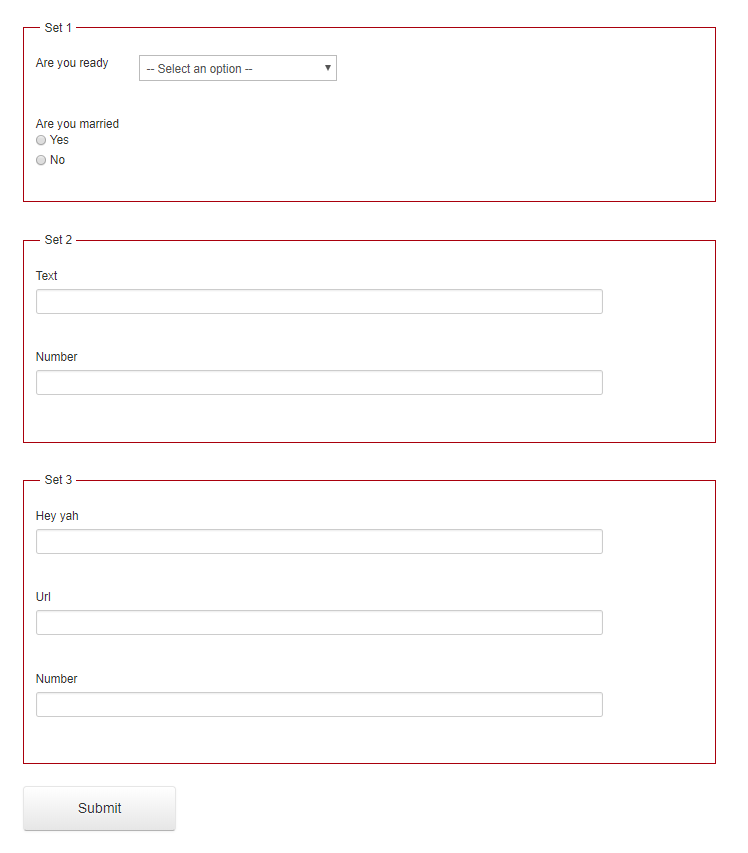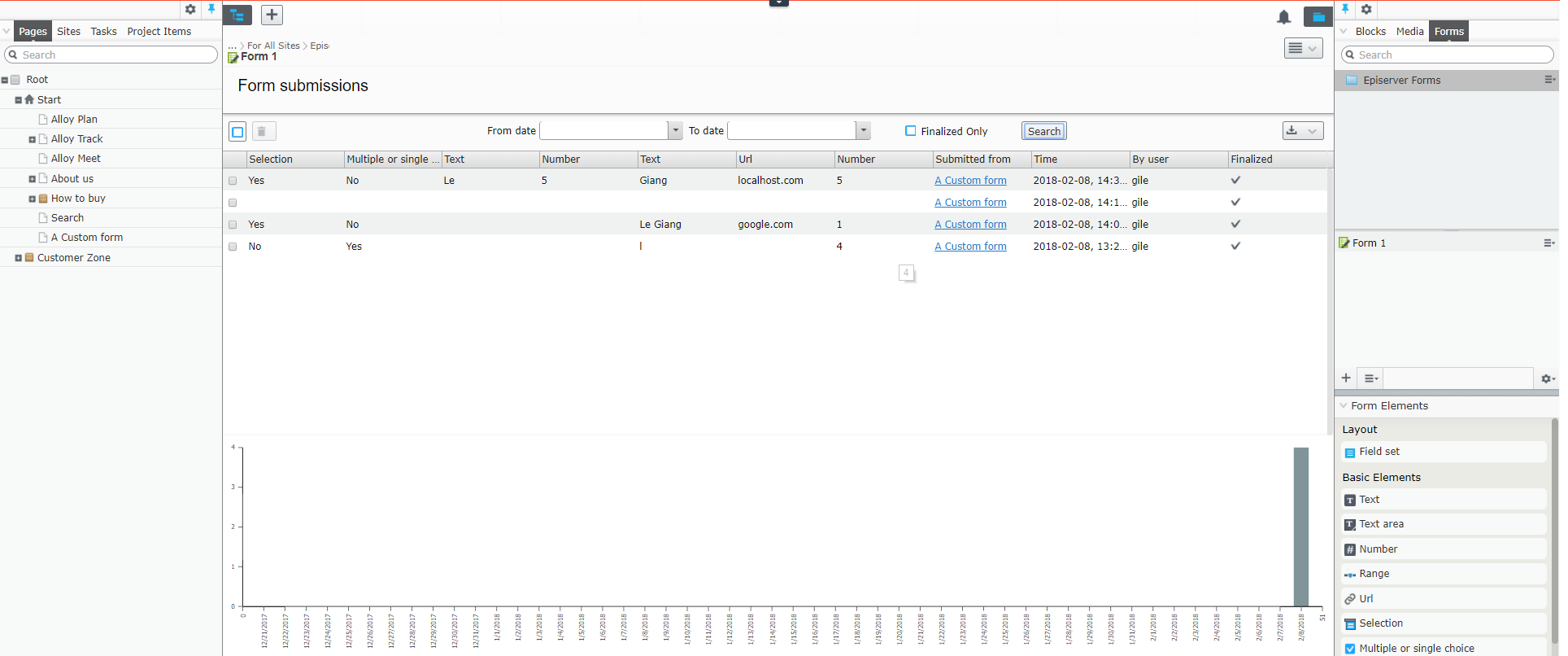Custom FieldSet emelent block for EPiServer.Form
Hi there.
In this post, I will show you how to create a custom field set element block for FORM addon. This block aims to group some of form elements and add some pretty appearances for the form. And this is what we will achieve.


- Create a new form element block called "FieldsetBlock" which cotains a element area allow user to drag and drop other form elements into. I also introduce a new interface called "IFieldSet", we will use this for some additional logic later.
[ContentType(GUID = "2A4F56F9-2D3A-4C0A-AD78-1381D6A57808", GroupName = "Layout", DisplayName = "Field set")] public class FieldsetBlock: ElementBlockBase, IFieldSet, IExcludeInSubmission { [AllowedTypes(new[] { typeof(DataElementBlockBase) })] [Display(GroupName = "Elements")] [UIHint("FormsContentAreaEditor")] public virtual ContentArea ElementsArea { get; set; } public virtual string Title { get; set; } } public interface IFieldSet { ContentArea ElementsArea { get; set; } } - Create a view for the FieldsetBlock
@model EpiserverSite2.Models.FormElement.FieldsetBlock <div class="Form__Element fieldsetBlock"> <fieldset> <legend class="fieldset_title" @Html.EditAttributes(x => x.Title)>@Model.Title</legend> @Html.PropertyFor(x => x.ElementsArea) </fieldset> </div> - By the default, form elements have no on-page edit view, but the field set element need one. Add this code to restore the on-page edit view for the field set element:
[UIDescriptorRegistration] public class FieldsetBlockUIDescriptor: UIDescriptor<FieldsetBlock> { public FieldsetBlockUIDescriptor() { DisabledViews = new List<string>(); } } - We need to override the way the FORM retrieves form elements to include "sub elements" contained in the field set blocks. We have to because by the default, FORM only retrieves "first-level" elements.
[ServiceConfiguration(ServiceType = typeof(DataSubmissionService), Lifecycle = ServiceInstanceScope.Singleton)] public class CustomDataSubmissionService : DataSubmissionService { protected override IFormStep GetCurrentStep(NameValueCollection rawSubmittedData, FormContainerBlock formContainer) { var step = base.GetCurrentStep(rawSubmittedData, formContainer); var lang = (formContainer as ILocale).Language.Name; var elements = new List<IFormElement>(step.Elements); foreach (var el in step.Elements) { if (el.SourceContent is IFieldSet) { var allElements = (el.SourceContent as IFieldSet).ElementsArea.Items; foreach (var item in allElements) { var formElementBlock = item.ContentLink.GetContent(lang) as ElementBlockBase; if (formElementBlock != null && !elements.Contains(formElementBlock.FormElement)) { elements.Add(formElementBlock.FormElement); } } } } step.Elements = elements; return step; } }[ServiceConfiguration(ServiceType = typeof(FormBusinessService), Lifecycle = ServiceInstanceScope.Singleton)] public class CustomFormBusinessService: FormBusinessService { public override IEnumerable<ElementBlockBase> GetDisplayableFormElementBlocks(FormContainerBlock formContainerBlock) { var allElements = GetFormElementBlocks(formContainerBlock, false); var elementList = new List<ElementBlockBase>(allElements); var lang = (formContainerBlock as ILocale).Language.Name; foreach (var el in allElements) { if (el is IFieldSet) { var allSubElements = (el as IFieldSet).ElementsArea?.Items; if (allSubElements != null && allSubElements.Count > 0) { foreach (var item in allSubElements) { var formElementBlock = item.ContentLink.GetContent(lang) as ElementBlockBase; if (formElementBlock != null && !elementList.Contains(formElementBlock)) { elementList.Add(formElementBlock); } } } } } return elementList; } /// <summary> /// Return all FormElementBlock of this FomrContainer, regardless the publish, visibility status or personalization content condition. /// </summary> /// <returns></returns> public override IEnumerable<ElementBlockBase> GetAllInnerFormElementBlocks(FormContainerBlock formContainerBlock) { var allElements = GetFormElementBlocks(formContainerBlock, true); var elementList = new List<ElementBlockBase>(allElements); var lang = (formContainerBlock as ILocale).Language.Name; foreach (var el in allElements) { if (el is IFieldSet) { var allSubElements = (el as IFieldSet).ElementsArea?.Items; if (allSubElements != null && allSubElements.Count > 0) { foreach (var item in allSubElements) { var formElementBlock = item.ContentLink.GetContent(lang) as ElementBlockBase; if (formElementBlock != null && !elementList.Contains(formElementBlock)) { elementList.Add(formElementBlock); } } } } } return elementList; } }
Make sure these custom services take place the original ones.context.Services.AddTransient<DataSubmissionService, DataSubmissionService>() .AddTransient<DataSubmissionService, CustomDataSubmissionService>(); context.Services.AddTransient<FormBusinessService, FormBusinessService>() .AddTransient<FormBusinessService, CustomFormBusinessService>(); - Since we have changed the way FORM retrieves form elements, so we have to remove redundant elements and empty field sets before rendering the form. To do this, we need a custom form container block controller.
[TemplateDescriptor(AvailableWithoutTag = true, Default = true, ModelType = typeof(FormContainerBlock), TemplateTypeCategory = TemplateTypeCategories.MvcPartialController)] public class CustomFormContainerBlockController: FormContainerBlockController, IRenderTemplate<FormContainerBlock> { public override ActionResult Index(FormContainerBlock currentBlock) // Note: convention, the parameter must be "currentBlock", not formBlock or another { var result = base.Index(currentBlock) as PartialViewResult; var formModel = result.Model as FormContainerBlock; if (formModel != null) { var steps = new List<IFormStep>(formModel.Form.Steps); var allSubItems = new List<ContentReference>(); // find all sub items (child of FieldSetElement) foreach (var step in steps) { foreach(var el in step.Elements) { if (el.SourceContent is IFieldSet) { var fieldSetElement = el.SourceContent as IFieldSet; if (fieldSetElement.ElementsArea != null && fieldSetElement.ElementsArea.Items.Count > 0) { allSubItems.AddRange(fieldSetElement.ElementsArea.Items.Select(i => i.ContentLink)); } } } } // Remove redundant elements foreach (var step in steps) { var elements = new List<IFormElement>(step.Elements); foreach (var el in step.Elements) { if (el.SourceContent is IFieldSet) { var fieldSetElement = el.SourceContent as IFieldSet; if (fieldSetElement.ElementsArea == null || fieldSetElement.ElementsArea.Items.Count == 0) { elements.Remove(el); } } if (allSubItems.Contains(el.SourceContent.ContentLink)) { elements.Remove(el); } } step.Elements = elements; } formModel.Form.Steps = steps; } return result; } - Finally, add some style for the field set element.
.fieldsetBlock fieldset { border: 1px groove red; padding: 1em; } .fieldsetBlock fieldset legend { width: auto; margin: 0 5px; padding: 0 5px; }

awesome :). Our clients will love this.
This is amazing !. Greate work man.
Great post. Thanks for sharing.